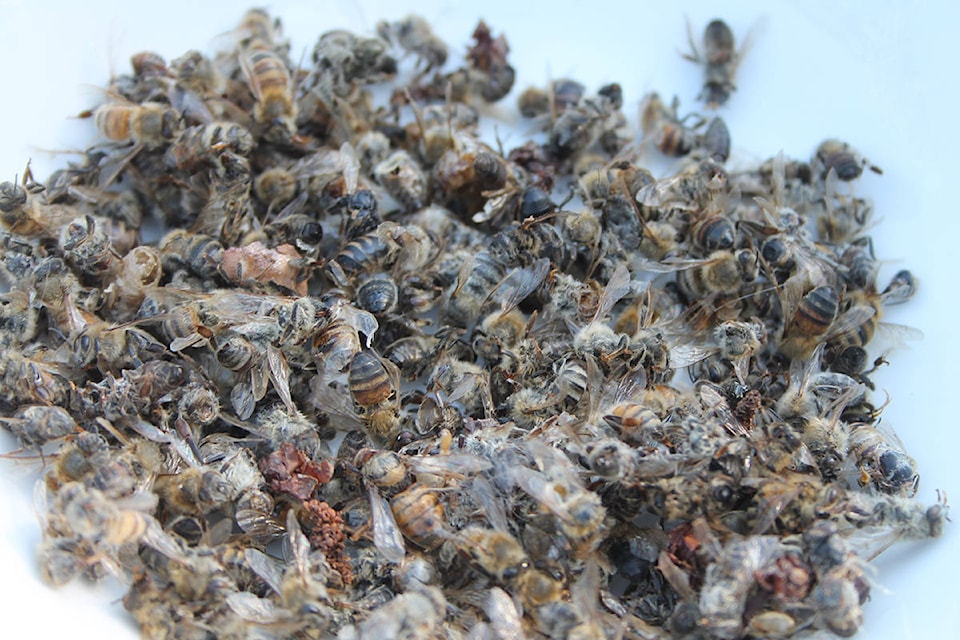On Friday June 14, Ladysmith area beekeeper Paula Masyk woke up to find enough dead bees in her garden to fill a bowl.
“There’s probably about 30 more deaths since I picked them up,” Masyk said.
Masyk has been keeping bees for a little over two months, and has had two pesticide events since then. She’s now pleading for pesticide users to spray pesticides more responsibly.
When bees are poisoned by pesticides, they crawl around outside the hive in a disoriented state before dying with their tongues out. Normally, bees die far from the hive, and only have their tongues stuck out when they are suffering from pesticide poisoning.
Bees can fly up to three kilometres away from the hive. Masyk believes the bees are dying from collecting pollen from dandelions that were sprayed with pesticides. When bees return from foraging, their back legs are covered in pollen. Beekeepers can tell which flowers bees have visited by the colour of the pollen they carry. Dandelion pollen is red, and that’s the pollen Masyk noticed on the bees before they started dying en mass.
RELATED: Health Canada upholds decision to keep glyphosate products on the market
“We could tell when it happened that they were collecting dandelion pollen,” she said. “It’s probably Killex because you spray it on your lawn and it kills broadleaf weeds like dandelions, but it won’t kill the grass.”
Masyk isn’t sure where the pesticides are being sprayed, just that they must be present somewhere in a three kilometre radius.
“What happened to our hive is our foragers — the oldest bees are these guys — they fly around and bring back nectar and pollen to the hive. When they die, then there’s nothing to feed the babies, so the larva start dying, and there’s no nurse bees for the other larva. So the balance between the larva, the nurse bees, and the foragers get all out of whack,” Masyk said.
Shortly after the first pesticide event, the queen bee in Masyk’s hive began acting erratically and laying eggs in an irregular pattern. This led to the hive getting weakened, and susceptible to disease. The hive became infected with sacbrood, a viral disease that infects bee larvae and kills them before they reach maturity. After the sacbrood infection, beetles came in to the hive trying to steal nectar. Masyk then decided to get a new queen for the hive. She now has to wait and see if the hive will accept the queen or not, but the day after the new queen was placed in the hive, there was another pesticide event.
“They’re in recovery, because if they’re not strong enough, they’ll die over the winter,” Masyk said.
Masyk hold a bachelors degree in horticulture, and managed a commercial garden for two decades. During that time, she held a government license to apply pesticides. She says the more she learned about pesticides, the less she wanted to use them. Now she wants to share her knowledge of responsible pesticide use, and pesticide alternatives with the public.
RELATED: The search for an effective way to save honeybees
“You can’t tell people what to do,” she said. “If someone wants to spray dandelions on their lawn, they should mow the lawn first, then there’s no flowers. It’s actually more efficient for the pesticide, because the pesticide needs to go right on the leaves, so by the time the new flowers come out, there will be no pesticide on them.”
“Another thing would be water. If you have buckets of water, or a bird bath, or a pond, and you’re not careful when you’re spraying, then it’s in the water. Any birds, or bees, or anything that goes in there will get poisoned. If you’re spraying an apple tree, then don’t spray it when the flowers are on. We put sticky traps instead of spraying, but we didn’t even do that when the flowers were on because we didn’t want any bees to be stuck in there.”
Masyk also encouraged pesticide users to spray at night-time when pollinators are less active, or to spray early in the morning. On top of that, she said people should be cautious about what kind of pesticides they use, and to notify the local beekeepers associations before they spray pesticides so beekeepers can cover their hives. Sometimes pesticides leave traces for only hours, but sometimes they stay around for weeks.
Although Masyk is concerned about the health of her hive, she’s more concerned about wild pollinators that are native to the area.
“All of these things are pollinating away, and we don’t notice what’s happen with them. I notice what’s happening with mine, but if these bees are dying, then it’s going to affect everything,” she said. “Even if this hive wasn’t here, the same thing would be happening, I just wouldn’t know. If somebody sprays within three kilometres, how many pollinators are affected?”
